Orion’s Belt is a prominent asterism formed by three stars in the constellation Orion. The three bright blue stars – Alnitak, Alnilam, and Mintaka – outline the belt in the constellation figure of the celestial Hunter. Appearing as three stars in a row, Orion’s Belt stars lie more than 1,000 light-years away and are among the brightest stars in the sky.
Orion’s Belt is one of the most familiar asterisms in the night sky, along with the Big Dipper in the northern sky and the Southern Cross in the southern. The asterism is easy to find because is part of one of the most prominent stellar patterns in the northern sky, the hourglass-shaped constellation figure of Orion. The asterism and the constellation dominate the evening sky from November to February.
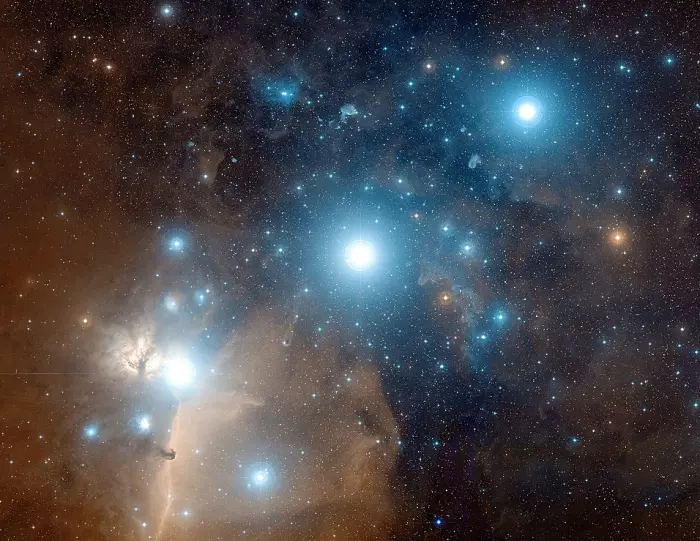
Photograph of Orion’s Belt with the stars Alnitak, Alnilam and Mintaka. The color picture was composited from digitized black and white photographic plates recorded through red and blue astronomical filters, with a computer synthesized green channel. The plates were taken using the Samuel Oschin Telescope, a wide-field survey instrument at Palomar Observatory, between 1987 and 1991. Image credit: Davide De Martin (http://www.skyfactory.org); Credit: Digitized Sky Survey, ESA/ESO/NASA FITS Liberator
Constellation
Orion’s Belt is the most conspicuous feature of the constellation Orion. The Hunter is one of the most recognizable constellations in the sky. Its major stars form a distinctive human figure in the sky that represents the Greek mythical character.
The seven brightest stars in Orion outline the Hunter’s hourglass-shaped figure. Meissa (Lambda Ori) marks the head, Betelgeuse (Alpha Ori) and Bellatrix (Gamma Ori) the shoulders, Alnitak (Zeta Ori), Alnilam (Epsilon Ori) and Mintaka (Delta Ori) the belt, and Saiph (Kappa Ori) and Rigel (Beta Ori) the knees or feet.
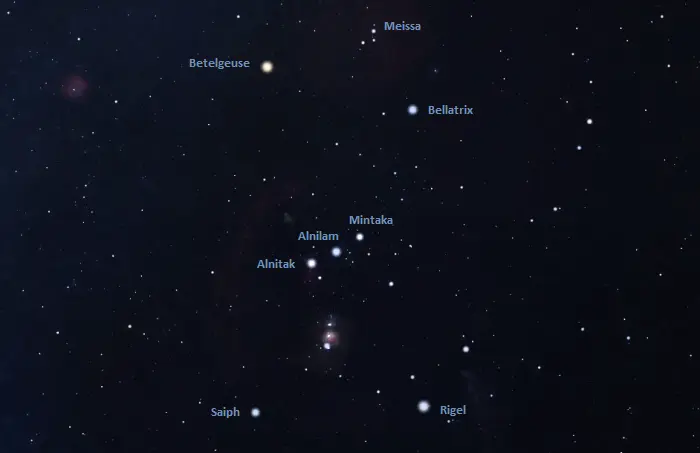
The constellation figure of Orion, image: Stellarium
Orion is one of the oldest constellations in the sky. In Greek mythology, it represents the giant huntsman Orion, who incurred the wrath of the goddess Gaia by saying that he would hunt down every animal on Earth. According to legend, Gaia sent a scorpion to prove him wrong. Orion was unable to defeat the scorpion and met his end after being stung by it. The gods placed them both into the heavens as constellations.
Orion and Scorpius are never seen in the sky at the same time. Orion is best seen during the northern hemisphere winter, while Scorpius is prominent in the summer sky, when Orion stays below the horizon.
The constellation Orion is depicted as the human figure of a hunter chasing a hare (Lepus) with his two dogs (Canis Major and Canis Minor) or, alternatively, facing the charge of the Bull (Taurus). It is sometimes depicted as chasing the Pleiades, the Seven Sisters, across the sky.
The Belt of Orion is one of the three prominent asterisms that define the constellation figure of Orion, along with Orion’s Sword and Orion’s Shield.
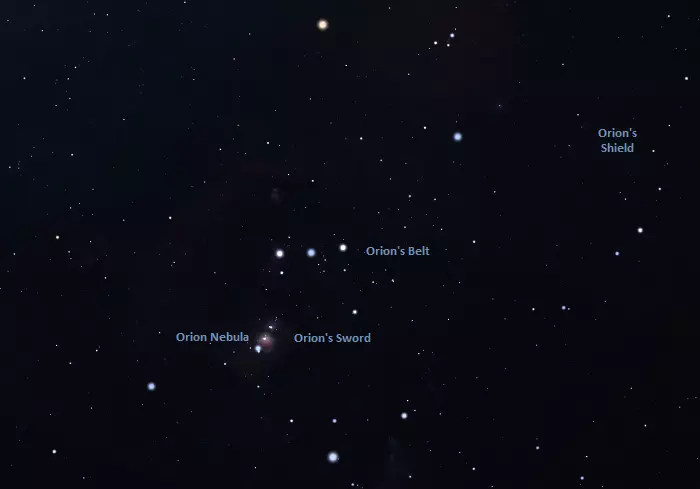
Orion’s Belt, Orion’s Sword, Orion Nebula and Orion’s Shield, image: Stellarium
Orion’s Sword lies in the region between the Belt and the feet. It is formed by three points of light: the young star 42 Orionis and the Running Man Nebula (NGC 1977), the bright Orion Nebula (Messier 42) with the Trapezium Cluster, and the multiple star system Iota Orionis, which is part of the open cluster NGC 1980.
The six stars and star systems that share the designation Pi Orionis form Orion’s Shield (or Orion’s Bow), which appears to the right of the hourglass.
The 10 brightest stars in Orion are Rigel (β Orionis), Betelgeuse (α Orionis), Bellatrix (γ Orionis), Alnilam (ε Orionis), Alnitak (ζ Orionis), Saiph (κ Orionis), Mintaka (δ Orionis), Hatysa (ι Orionis), Tabit (π3 Orionis), and Eta Orionis. The supergiants Rigel and Betelgeuse are the seventh and tenth brightest stars in the sky.
Stars
Orion’s Belt consists of three exceptionally hot and massive blue stars, Alnitak, Alnilam, and Mintaka. The stars are evenly spaced and form a more or less straight line, which makes them easy to identify. Two of the three stars are supergiants.
The stars formed in the same molecular cloud and are roughly the same age. Alnitak and Mintaka, the leftmost and rightmost stars of Orion’s Belt, lie at a similar distance, about 1,200 light-years from the Sun, while Alnilam, the central star of the Belt, is much more distant. It lies approximately 2,000 light-years away. This means that, even though Alnitak and Mintaka appear closer to Alnilam in the sky, they are in fact closer to each other.
The three stars are part of the Orion OB1b subgroup of the Orion OB1 association. They were formed in the larger Orion Molecular Cloud Complex, the nearest massive star-forming region to Earth.
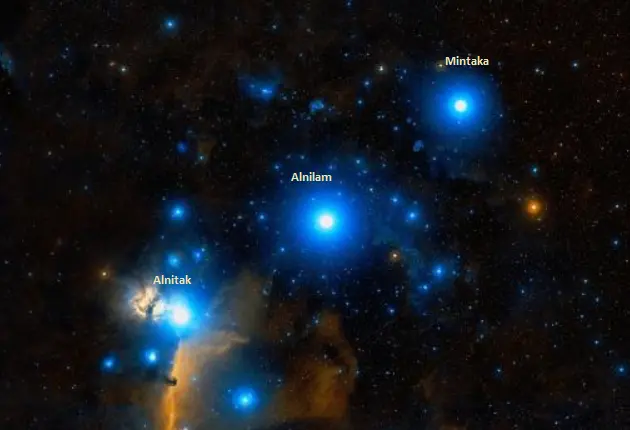
The stars of Orion’s Belt, image: Wikisky
Alnitak
Alnitak, Zeta Orionis (ζ Ori), is the leftmost star of Orion’s Belt. It is the primary star in a triple star system located approximately 1,260 light-years away.
The three components of the Zeta Orionis system are hot, luminous blue O- and B-type stars. They have a combined apparent magnitude of 1.77. The individual components shine at magnitudes 2.08, 4.28, and 4.01.
The primary component, Zeta Orionis Aa, is formally known as Alnitak. The name comes from the Arabic word an-niṭāq, meaning “girdle.” It was historically also spelled Al Nitak or Alnitah.
Alnitak is a hot blue supergiant of the spectral type O9.5Iab. It has a mass 33 times that of the Sun and a radius 20 times solar. With an effective temperature of about 29,500 K, it shines with 250,000 solar luminosities. The star’s estimated age is only 6.4 million years.
Alnitak is the fifth brightest star in Orion and the 31st brightest star in the sky. It is slightly fainter than its Orion’s Belt neighbour Alnilam, but it outshines Mintaka.
Alnitak is the brightest O-type star in the sky. O-type stars are the hottest, bluest, and most massive types of stars, as well as the most short-lived. Because of their high mass, they burn through their supply of hydrogen faster than Sun-like stars. Even though it has only a fraction of the Sun’s age, Alnitak is already in the final stages of its life cycle. When it reaches the end, it will go out as a spectacular supernova.
Alnitak forms a close binary star system with a blue subgiant with the stellar classification B1IV. The binary star is sometimes referred to as Alnitak A.
The secondary component, Zeta Orionis Ab (Alnitak Ab), is not as evolved, but it has also come to the end of its main sequence lifetime. The star was only discovered in 1998. With a mass 14 times that of the Sun, it is also a supernova candidate. It has a radius 7.2 times solar and is 32,000 times more luminous than the Sun, with a surface temperature of 29,000 K. Alnitak Ab is a little older than its more massive companion, with an estimated age of 7.2 million years.
Alnitak Aa and Alnitak Ab orbit each other with a period of 2,687.3 days. They are separated by only 35.9 milliarcseconds, corresponding to a physical distance of only 11 astronomical units (Earth-Sun distances). The secondary component cannot be resolved visually even in the largest of telescopes. It can only be detected interferometrically and spectroscopically.
The third component, Zeta Orionis B, orbits the main pair with a period 1,508.6 years at a separation of 2.728 arcseconds. It is a blue giant star of the spectral type B0III.
There is a 9th magnitude star, sometimes called Alnitak C, that appears in the same line of sight. However, it is unclear whether it is physically related to the system or just an optical companion.
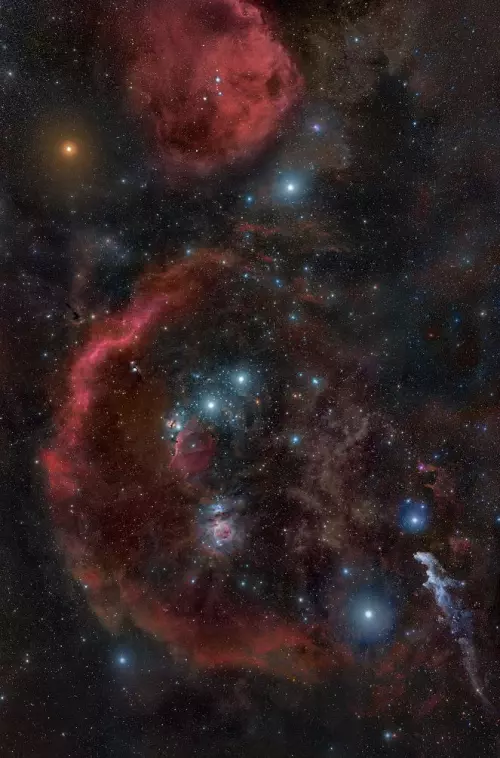
Photo taken by Rogelio Bernal Andreo in October 2010 of the Orion constellation showing the surrounding nebulae of the Orion Molecular Cloud Complex. Also captured is the red supergiant Betelgeuse (top left) and the famous Belt of Orion composed of the OB stars Alnitak, Alnilam and Mintaka. To the bottom right is the star Rigel. The red crescent shape is Barnard’s Loop. The photograph appeared as the Astronomy Picture of the Day on October 23, 2010. Image: Rogelio Bernal Andreo (CC BY-SA 3.0)
Alnilam
Alnilam, Epsilon Orionis (ε Ori), is the middle star of Orion’s Belt. It is a single star located approximately 2,000 light-years away. It has the stellar classification B0 Ia, indicating a luminous blue supergiant.
Even though Alnilam is the most distant of the three stars, it appears the brightest because it is the most massive and therefore the most intrinsically luminous of the Belt stars. Shining at magnitude 1.69, Alnilam is the fourth brightest star in Orion and the 29th-brightest star in the sky. Among the 30 brightest stars, only Deneb is more distant. The luminary of Cygnus lies 2,615 light-years away.
Alnilam and Deneb (Alpha Cygni) belong to the same class of variable stars, the Alpha Cygni variables. These are A- and B-type supergiant stars that experience non-radial pulsations. Some parts of their surfaces are contracting while others simultaneously expand. The pulsations cause the brightness to vary by about 0.1 magnitudes. Alnilam’s brightness has been observed to vary from magnitude 1.64 to 1.74.
The star’s spectrum also varies, possibly because of the dramatic mass loss that it is experiencing. Alnilam is losing mass about 20 million times more rapidly than the Sun. The mass loss is caused by the strong stellar winds that may reach up to 2,000 km/s.
The name Alnilam is derived from the Arabic al-niẓām, meaning “the string (of pearls).” It was historically also spelled Alnihan and Alnitam. The name may be related to the word nilam, meaning “sapphire.”
Alnilam has between 40 and 44 times the mass of the Sun and a radius of 32.4 solar radii. With an effective temperature of 27,500 K, it is 537,000 times more luminous than the Sun. It has an estimated age of 5.7 million years.
Even though it is a young star, Alnilam is already approaching the end of its life. It may evolve into a red supergiant more luminous than Betelgeuse over the next million years and will ultimately go out as a supernova.
Mintaka
Mintaka, Delta Orionis (δ Ori), is the rightmost star of Orion’s Belt (leftmost when seen from the southern hemisphere). With an apparent magnitude of 2.23, it is the seventh brightest star in Orion and the 73rd brightest star in the sky. It is the faintest star of Orion’s Belt and the only one that is not a supergiant.
The name Mintaka is derived from the Arabic manṭaqa, meaning “belt.”
Mintaka is the primary component in a star system located approximately 1,200 light-years away. It is a hot blue bright giant of the spectral type O9.5II. The star is a supernova candidate with a mass 24 times that of the Sun. It has a radius of 16.5 solar radii and a luminosity 190,000 times that of the Sun.
The primary component (Delta Ori Aa1) is part of a triple star system that also contains a hot blue B-type main sequence star (Delta Ori Aa2) and a B-type subgiant star (Delta Ori Ab). The closer companion, Delta Orionis Aa2, has a mass of 8.4 solar masses and a radius 6.5 times that of the Sun. With an effective temperature of about 25,600 K, it shines with 16,000 solar luminosities.
Delta Orionis Ab has a mass 22.5 times that of the Sun and a radius of 10.4 solar radii. It is 63,000 times more luminous than the Sun with a surface temperature of 28,400 K. It is separated by 0.26 arcseconds from the main pair and orbits the two stars with a period of 400 years or more.
All three stars are exceptionally fast spinners, with projected rotational velocities of 130 km/s (Mintaka), 150 km/s (Delta Ori Aa2), and 220 km/s (Delta Ori Ab).
Mintaka and Delta Ori Aa2 orbit each other with a period of 5.732436 days. The system is classified as an eclipsing binary star. The two stars periodically eclipse each other as they orbit, causing the system’s brightness to decrease. When the primary component eclipses the secondary, the brightness drops from magnitude 2.23 to 2.29, and when the primary star is eclipsed by the secondary, the brightness decreases to magnitude 2.35.
A fourth component, Delta Orionis B, is a 14th-magnitude star that may be related to the system, but its properties are not understood well enough to confirm this.
Delta Orionis C, catalogued as HD 36485, is another hot B-type main sequence star. It shines at magnitude 6.85 and consists of a spectroscopic binary pair. The two components orbit each other with a period of about 30 days.
Orion’s Belt stars
| Star | Alnitak | Alnilam | Mintaka |
| Bayer designation | Zeta Orionis Aa (ζ Ori Aa) | Epsilon Orionis (ε Ori) | Delta Orionis Aa (δ Ori Aa) |
| Flamsteed designation | 50 Orionis | 46 Orionis | 34 Orionis |
| Spectral type | O9.5Iab | B0 Ia | O9.5II |
| Apparent magnitude | 1.77 | 1.69 | 2.23 |
| Distance | 1,260 ± 180 light-years (387 ± 54 parsecs) | 2,000 light-years (600 parsecs) | 1,200 light-years (380 parsecs) |
| Mass | 33 ± 10 M☉ | 40 – 44 M☉ | 24 M☉ |
| Radius | 20.0 ± 3.2 R☉ | 32.4 R☉ | 16.5 R☉ |
| Luminosity | 250,000 L☉ | 537,000 L☉ | 190,000 L☉ |
| Temperature | 29,500 ± 1,000 K | 27,500 ± 100 K | 29,500 ± 500 K |
| Surface gravity | 3.2 ± 0.1 cgs | 3.0 cgs | 3.37 ± 0.15 cgs |
| Rotational velocity | 110 ± 10 km/s | 40 – 70 km/s | 130 ± 10 km/s |
Location
Orion’s Belt lies just below the celestial equator. The celestial equator is the projection of the Earth’s equator into space. The Sun appears directly above it during the equinoxes.
Orion is one of the 15 equatorial constellations. These constellations are visible from virtually anywhere on the globe for at least part of the year. They culminate highest when seen from locations near the equator. For northern observers, they never appear in the northern sky, nor do they appear above the southern horizon for observers in the southern hemisphere.
Orion’s Belt is one of the asterisms that can be used to find the declination 0° (the equator), along with the Head of Cetus, the Head of Hydra, the Water Jar of Aquarius, and the Y of Virgo. Mintaka, the westernmost star of Orion’s Belt, appears only a quarter of a degree south of the equator and is the nearest bright star to it.
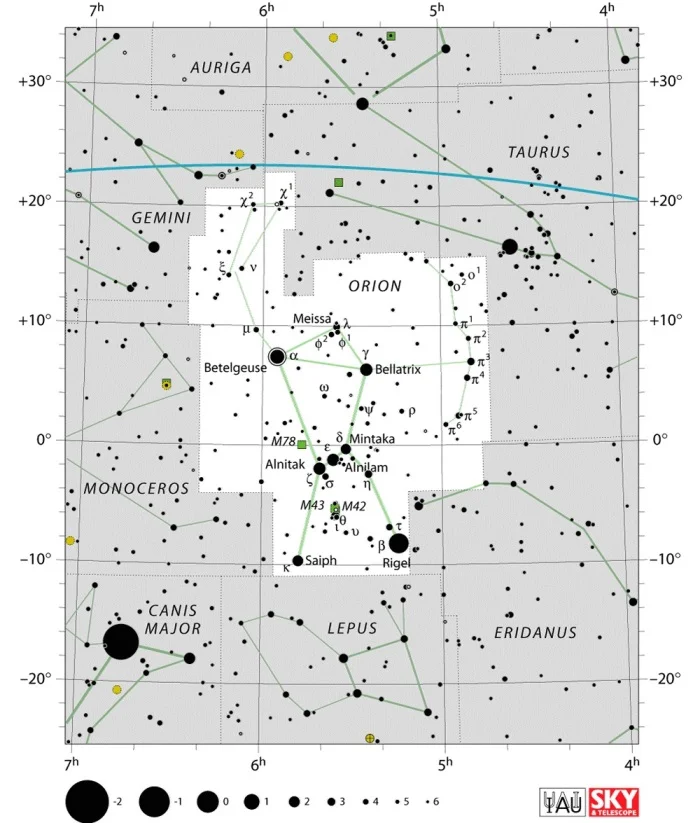
Orion constellation map by IAU and Sky&Telescope magazine
How to find Orion’s Belt
For observers in the northern latitudes, Orion’s Belt is visible throughout autumn, winter, and spring at some point in the night. In January, the constellation Orion appears high above the southern horizon around 10 pm. By April, it moves to the southwest and begins to set earlier. In May, it is low above the western horizon around 8 pm and sets after sunset.
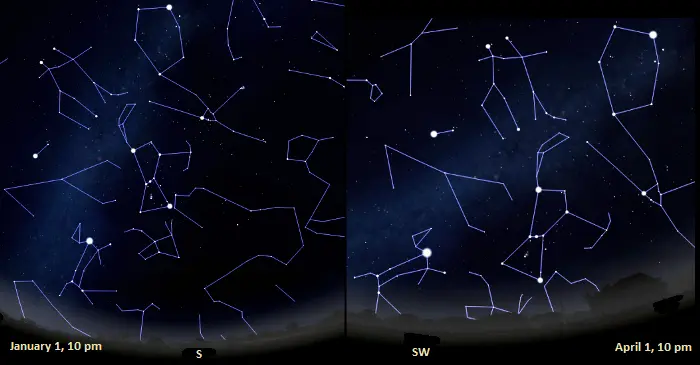
Orion’s Belt as it appears from the northern hemisphere in January and April, image: Stellarium
Orion disappears below the horizon during the early summer months. This is the only time of year during which it is invisible. In August, it rises with the Sun in the east around 5 am. By early October, it rises around midnight and is fully visible above the eastern horizon around 1 am.
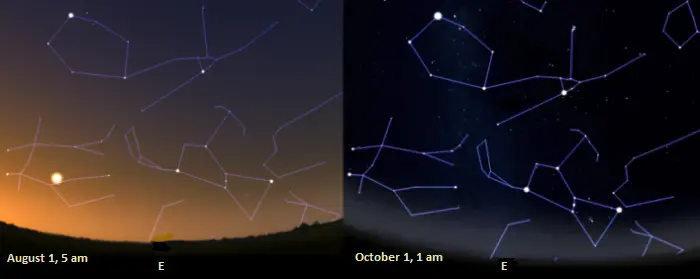
Orion’s Belt as it appears from the northern hemisphere in August and October, image: Stellarium
Orion dominates the evening sky during the northern hemisphere winter. The best time of the year to observe Orion’s Belt and the deep sky objects in Orion is during the month of January.
During the winter months, Orion’s Belt and the Big Dipper are both prominent in the night sky. The constellations appear in different parts of the sky, with the bright Gemini and the faint Lynx between them. A line extended through the Big Dipper’s bowl leads to Castor, the second brightest star in Gemini. The brighter Pollux is part of the Winter Circle, a large hexagonal asterism also formed by Capella in Auriga, Aldebaran in Taurus, Rigel in Orion, Sirius in Canis Major, and Procyon in Canis Minor.
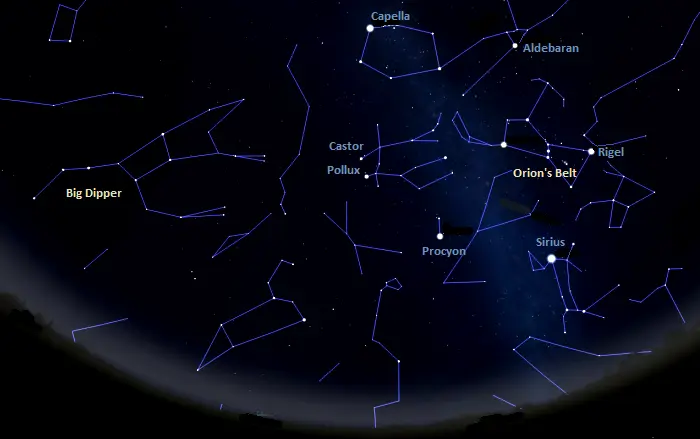
Orion’s Belt and the Big Dipper, image: Stellarium
For observers in the southern hemisphere, the hourglass figure of Orion appears upside down. In January, Orion’s Belt appears high in the northeastern sky, parallel to the horizon, around 10 pm. By April, it moves to the northwest and sets earlier in the evening, appearing perpendicular to the horizon.
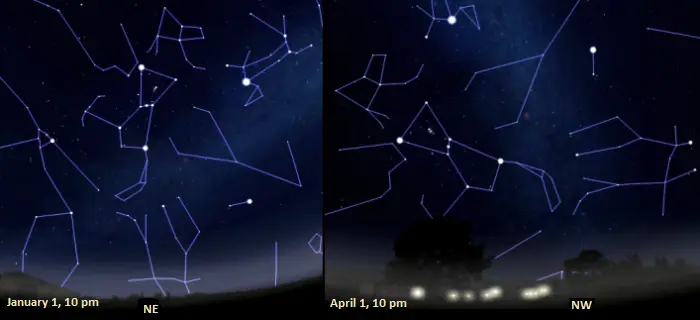
Orion’s Belt as it appears from the southern hemisphere in January and April, image: Stellarium
The constellation disappears during the early southern hemisphere winter and reappears in the east just before dawn in August. By October, it is visible above the eastern horizon by 2 am.
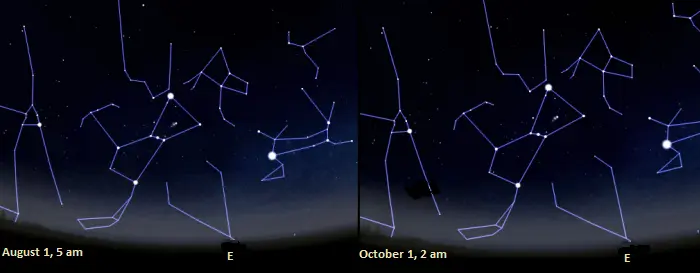
Orion’s Belt as it appears from the southern hemisphere in August and October, image: Stellarium
Constellations near Orion’s Belt
Orion’s Belt can be used to identify the brightest stars of Taurus and Canis Major. A line drawn through the Belt stars to the northwest leads to Aldebaran, the luminary of the constellation Taurus and the 14th brightest star in sky. Aldebaran appears as a member of the V-shaped Hyades cluster, which outlines the head of the Bull, but is much closer to us than the cluster. The orange giant marks the Bull’s eye.
The same line drawn past Aldebaran leads to the Pleiades, another exceptionally bright open cluster. Catalogued as M45 by the French astronomer Charles Messier, the Pleiades cluster marks the Bull’s shoulder.
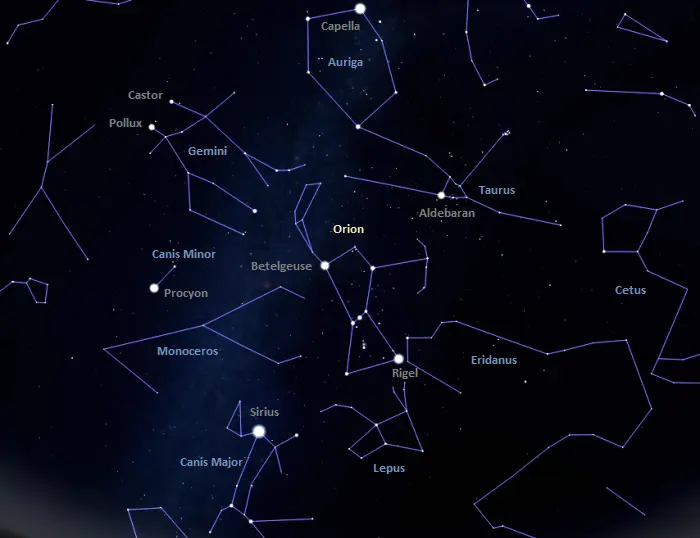
Constellations near Orion’s Belt, image: Stellarium
A line extended from the Belt stars to the southeast leads to Sirius, the brightest star in the sky. Popularly known as the Dog Star, Sirius is the brightest star in the constellation Canis Major and one of the nearest stars to the Sun. It lies only 8.60 light-years away.
The faint Monoceros (the Unicorn) appears east of Alnitak. The constellation is difficult to see from light-polluted areas, but it is well-known to stargazers because it contains several bright deep sky objects. The Rosette Nebula (C49), Hubble’s Variable Nebula (NGC 2261), and the Cone Nebula with the Christmas Tree Cluster (NGC 2264) appear in the region between Betelgeuse and Procyon.
Deep sky objects near Orion’s Belt
The region around Orion’s Belt is home to several bright and well-known deep sky objects. These objects are part of the larger Orion Molecular Cloud Complex, a vast star-forming region that stretches across most of the constellation Orion.
The brightest of these objects, the Orion Nebula (Messier 42), lies below Orion’s Belt and is part of an asterism known as Orion’s Sword. The stellar nursery appears as the middle of the three points of light that form the Sword. It lies 1,344 light-years away and is the nearest region of massive star formation to the Sun. With an apparent magnitude of 4.0, the nebula is easily visible to the unaided eye on a clear night. The young Trapezium Cluster at the centre of the nebula can be observed in small telescopes.
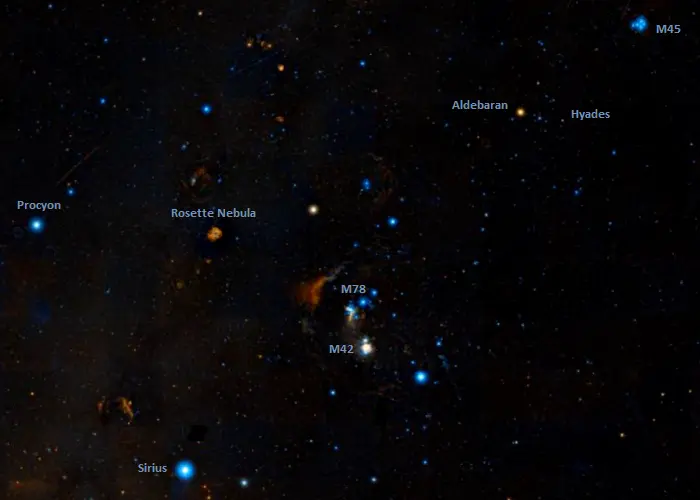
The deep sky objects near Orion’s Belt, image: Wikisky
The star-forming nebula Messier 43 (De Mairan’s Nebula) lies next to the Orion Nebula. The two are separated by a dark dust lane. M43 is considerably fainter than its larger neighbour. It has an apparent magnitude of 9.0.
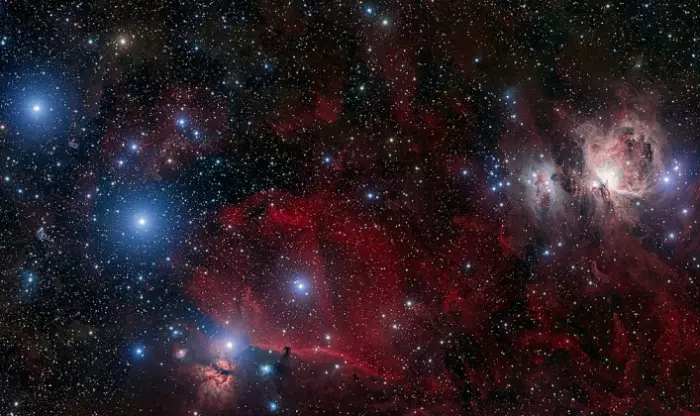
Orion’s Belt (left) and the Orion Nebula (right). Orion’s Belt or the Belt of Orion, also known as the Three Kings or Three Sisters, is an asterism and it consists of the three bright stars Alnitak, Alnilam and Mintaka. Alnitak (ζ Orionis) is a triple star system at the eastern end of Orion’s belt and is 1,260 light-years from the Earth. Alnilam (ε Orionis) is a supergiant, approximately 2,000 light-years away from Earth and magnitude 1.70. Mintaka (δ Orionis) is 1,200 light-years away and shines with magnitude 2.21. Mintaka is 90,000 times more luminous than the Sun. Mintaka is a double star. The Horsehead Nebula (also known as Barnard 33) is located just to the south of Alnitak. Orion’s Sword is a compact asterism in the constellation Orion. It comprises three stars (42 Orionis, Theta Orionis, and Iota Orionis) and M42, the Orion Nebula. Given the scientific significance of M42, Orion’s Sword is a popular spot for stellar and protostellar studies. Taken using 300mm and 200mm vintage telephoto lenses. Shots taken between 31 December 2021, 1 and 2 January 2022. Image credit: Giuseppe Donatiello (CC0 1.0)
The third Messier object in this region of the sky is the reflection nebula Messier 78. M78 is found at the intersection of the imaginary lines connecting Alnitak and Betelgeuse and Bellatrix and Sirius. It is part of a group of reflection nebulae that also includes NGC 2071, NGC 2064, and NGC 2067. It lies at a similar distance to M42 and M43.
The area around Orion’s Belt stars is populated by several nebulae. Alnitak, the easternmost star of Orion’s Belt, ionizes the Flame Nebula (NGC 2024), an emission nebula located approximately 1,350 light-years away. The nebula has an apparent magnitude of 10. Its distinctive shape and the colourful surroundings of the Orion’s Belt region make it a popular astrophotography target.
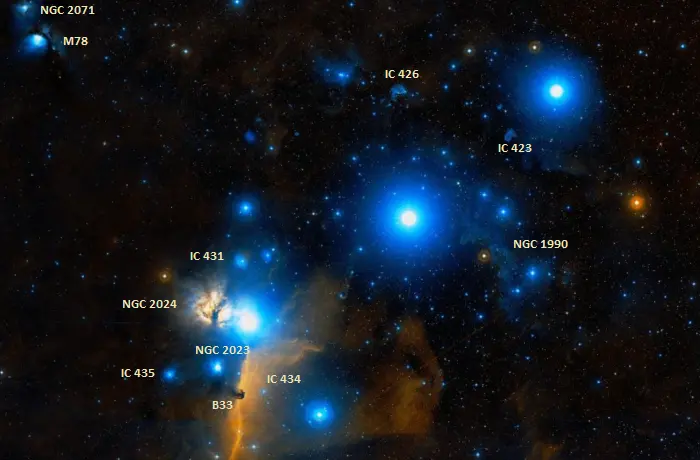
Deep sky objects near Alnitak, Alnilam and Mintaka, image: Wikisky
The Horsehead Nebula (Barnard 33), one of the best-known dark nebulae in the sky, appears just south of Alnitak. The Horsehead is backlit by the emission nebula IC 434 and is part of a large dust cloud catalogued as Lynds 1630 (LND 1630).
The emission and reflection nebula NGC 2023 appears between the Horsehead and Flame Nebulae. It is located 1,300 light-years away. The smaller reflection nebulae IC 431 and IC 435 also appear near Alnitak.
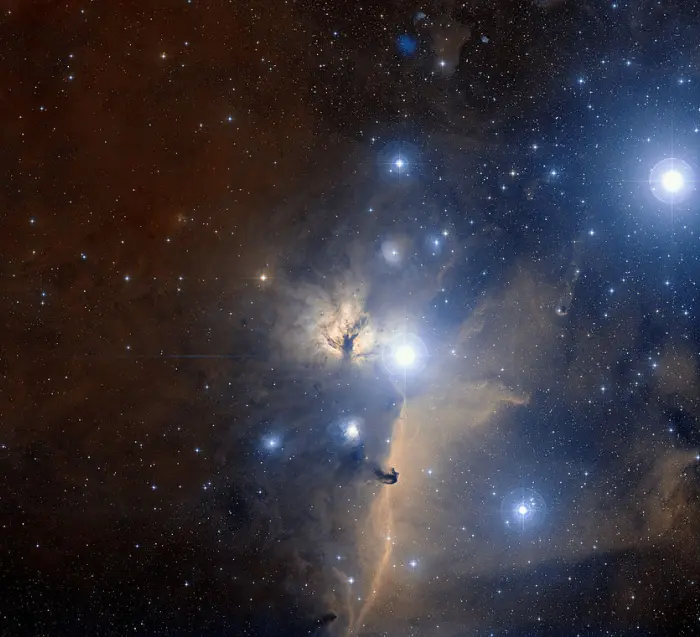
This spectacular visible light wide-field view of part of the famous belt of the great celestial hunter Orion shows the region of the sky around the Flame Nebula. The whole image is filled with glowing gas clouds illuminated by hot blue young stars. It was created from photographs in red and blue light forming part of the Digitized Sky Survey 2. The field of view is approximately three degrees. Image: ESO and Digitized Sky Survey 2 (CC BY 4.0)
Alnilam was reported to be surrounded by a reflection nebula catalogued as NGC 1990 by William Herschel in 1786. However, it is still unclear whether or not the object exists because it has not been detected by modern photographs.
Several smaller reflection nebulae appear near Alnilam and Mintaka. These include IC 423 and IC 426.
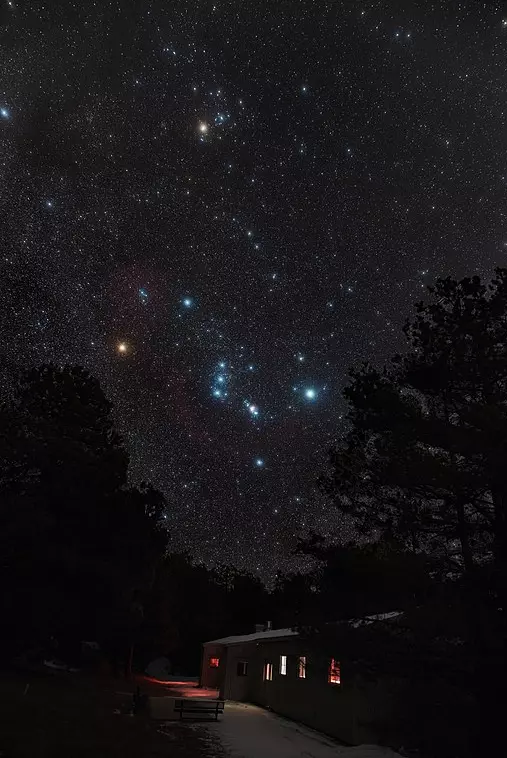
Orion’s Belt, Aldebaran and the Hyades, credit: Adam Block (CC BY-SA 4.0)
Facts
The three stars of Orion’s Belt are members of the Orion OB1b group, a subgroup of the larger Orion OB1 association. They were formed in the same molecular cloud and share a common proper motion through space. For this reason, Orion’s Belt looks more or less the same as it did millennia ago.
Orion’s Belt and the constellation Orion have been known since prehistoric times. A mammoth ivory carving depicting Orion was discovered in a cave in West Germany in 1979. It is believed to be between 32,000 and 38,000 years old.
As one of the brightest and most distinctive constellations in the sky, Orion has been associated with many myths in cultures around the world, including the ancient civilizations of Egypt, Greece, and Rome. The constellation was mentioned as MULSIPA.ZI.AN.NA in the Babylonian star catalogues of the Late Bronze Age.
In western culture, Orion’s Belt stars are most commonly associated with the Biblical story of the Three Kings (Magi). The asterism was mentioned in the Bible, Job 38.31 (“Canst thou bind the sweet influences of Pleiades, or loose the bands of Orion?”).
Mythology and culture
Orion’s Belt has historically carried a lot of significance both in eastern and western cultures. English folk names for the asterism include Jacob’s Staff (or Jacob’s Rod), the Yard-stick (or Yard-wand), the Golden Yard-arm, the Ellwand, the Ell and Yard, Peter’s Staff, Our Lady’s Wand, the Three Stars, the Three Kings (the Magi), and the Three Marys.
The Greeks associated the stars with the mythical hunter Orion. The constellations Canis Major and Canis Minor represented the hunter’s dogs and the constellation Scorpius was associated with the scorpion that stung Orion. It is said that Orion and Scorpius were placed on opposite ends of the sky so that they are never above the horizon at the same time.
In ancient Egypt, the stars of Orion’s Belt were the symbol of Osiris, but the extent of their importance has only been speculated about. Orion stars were associated with the god Sah. Sah’s consort, Sopdet (Sothis), was the goddess of the star Sirius. Sah and Sopdet were later syncretized with Osiris and his wife Isis. Sah was mentioned in the Pyramid Texts from the 24th and 23rd centuries BCE as one of the gods whose form pharaohs take after passing. Ancient Egyptians believed that the gods descended from Sirius and the Belt of Orion and instigated the human race.
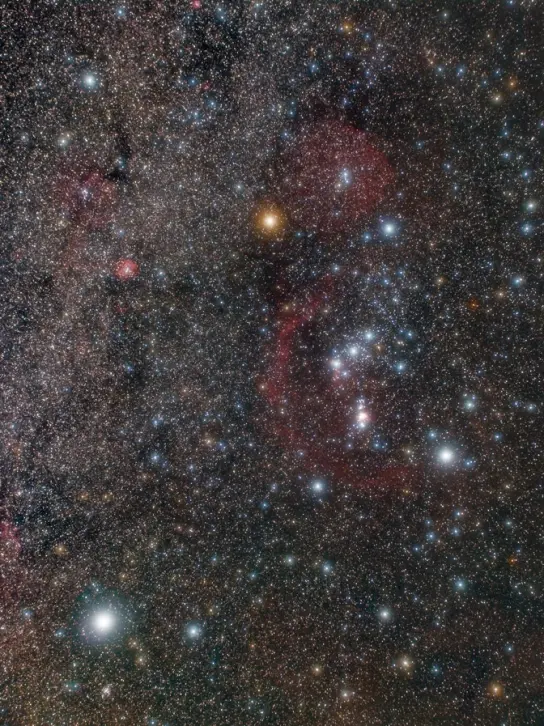
Sirius and the Belt of Orion, image credit: Boris Stromar (CC BY-SA 4.0)
The stars were collectively known by different names in different cultures. The names include the Weighing Beam in Chinese and Al Nijād (the Belt), Al Nasak (the Line), Al Alkāt (the Golden Grains/Nuts) and Al Mīzān al Ḥaqq (the Accurate Scale Beam) in Arabic.
In Scandinavian lore, Orion’s Belt is known as Frigg’s Distaff (Friggerock) or Freya’s Distaff.
In Finland, the asterism and the stars appearing below it are known as Väinämöisen viikate (Väinämöinen’s scythe) or Väinämöisen vyö (Väinämöinen’s Belt). The stars that appear to be hanging from the Belt are known as Kalevanmiekka (Kaleva’s sword). Väinämöinen and Kalevi are heroic figures in Finnish folklore. They are characters in the 19th-century national epic Kalevala by Elias Lönnrot.
In Hungary, the Belt of Orion is traditionally known as Bírópálca, “Judge’s stick.”
In Spain and South America, Orion’s Belt stars are known as Las Tres Marías (Spanish) or As Três Marias (Portuguese), meaning the Three Marys. In Puerto Rico, Mexico and the Philippines they are called Los Tres Reyes Magos, meaning “the three Wise Men,” referring to the Three Kings or the Biblical Magi who visited baby Jesus.
The Seri people in northwestern Mexico call Orion’s Belt Hapj. The name denotes a hunter. Hapj consists of three stars: Hap (mule deer), Haamoja (pronghorn), and Mojet (bighorn sheep). In local lore, the mule deer (Hap) is in the centre and has been shot by the hunter. Its blood has dripped on Tiburón Island in the Mexican state of Sonora, the traditional home of some clans of the Seri people.
The Aymara people of the Andean highlands in Bolivia, Chile and Peru see the Belt of Orion as a celestial bridge connecting the northern and southern celestial hemispheres.
The Lakota Native Americans call the asterism Tayamnicankhu and see it as the spine of a bison. The bison’s ribs are outlined by the rectangle of Orion and its head is marked by the Pleiades, while Sirius marks its tail.
In Australia and New Zealand, the constellation figure of Orion appears upside down, and Orion’s Belt and Sword are sometimes called the Saucepan or the Pot.
The Māori people of New Zealand call Orion’s Belt Tautoru, meaning “a string of three.” The asterism represents the stern in the constellation known as Te Waka o Rangi (the canoe of Rangi). The prow of the canoe extends to the Pleiades (Matariki). Matariki is known as the Māori New Year, which is marked by the rising of the Pleiades between late May and early July. The exact dates depend on the tribe and geography.
Afrikaans speakers in South Africa know Orion’s Belt as Drie Konings (Three Kings) or the Drie Susters (Three Sisters). The name Driekoningen was often used in Dutch charts in the 17th and 18th centuries.
In Chinese astronomy, the Orion’s Belt stars were known as 參宿 (Shēn Sù), meaning Three Stars. The Three Stars asterism originally consisted of Alnitak, Alnilam, and Mintaka, and other bright Orion stars – Rigel, Betelgeuse, Bellatrix, and Saiph – were added later. Alnitak was known as 參宿一 (Shēn Xiù yī), the First Star of Three Stars, Alnilam as 參宿二 (Shēn Sù èr), the Second Star of Three Stars, and Mintaka as 參宿三 (Shēn Sù sān), the Third Star of Three Stars.
In the Chinese Classic of Poetry (Book of Songs), the oldest existing collection of Chinese poetry, the Three Stars asterism (Shen) was paired with Sheng (Antares). The stars were seen as a metaphor for two people who could never unite. Antares, the brightest star in Scorpius, never rises until Orion’s Belt has set.
In India, Orion’s Belt is associated with Shravana Kumara, a character from the old Hindu text Ramayana. The Gond community of India knows the asterism as Tipan (Three Stars). They know that the monsoon comes when Tipan appears at sunset. Orion’s Belt and Sword are called Naagarda (a plough). When they appear in the early night sky, they signal the beginning of the farming season.
Pyramids
In Egyptology, the Orion correlation theory posits that the layout of the three pyramids on the Giza Plateau simulates the alignment of the three Orion’s Belt stars, and that the air shafts inside the pyramids point directly toward the Orion constellation. They are believed to be there to project the pharaoh’s soul toward Orion. While this theory is heavily disputed, the correspondence between the stars and the pyramids is quite remarkable.
The Belt stars are not perfectly aligned, and their alignment matches that of the three pyramids. The proponents of the Orion correlation theory have also suggested that Orion’s orientation to the Milky Way matches the pyramids’ orientation to the river Nile, but this has been a matter of debate.

Aerial photo of the Giza pyramid complex, image: © Raimond Spekking / CC BY-SA 3.0 (via Wikimedia Commons)
Teotihuacán
A similar correspondence was discovered in the ruins of the ancient city of Teotihuacán, which lies 35 miles northeast of Mexico City. Two large pyramids and a temple, believed to have been built in the 2nd century BCE, point directly to Orion’s Belt, and their layout mimics that of the three Belt stars.
In local lore, the construction of the ancient city was attributed to a race of giants, the Quinametzin Giants, who were believed to have populated the world in an earlier era. The pyramid of the Sun in Teotihuacán is exactly half as tall as the Great Pyramid of Giza.
Thornborough Henges
The Thornborough Henges, an ancient monument complex in North Yorkshire, England, features a similar alignment. The complex is believed to have been a part of a Neolithic and Bronze Age ritual site dating back to between 3500 BCE and 2500 BCE.
Nicknamed “the Stonehenge of the North,” the complex contains three henges that appear to mirror the alignment of Orion’s Belt. Some historians believe that this is not coincidental because the structure had an astronomical purpose.
Pyramids of Xi’an
A complex of about 16 pyramids near the ancient city of Xi’an in China features three pyramids that align similarly to the stars of Orion’s Belt. The pyramids are believed to be 4,500 years old. Like the Egyptian pyramids, they may have been built to mirror the shape of Orion’s Belt. The famous Terra Cotta Warriors were discovered in the same location.